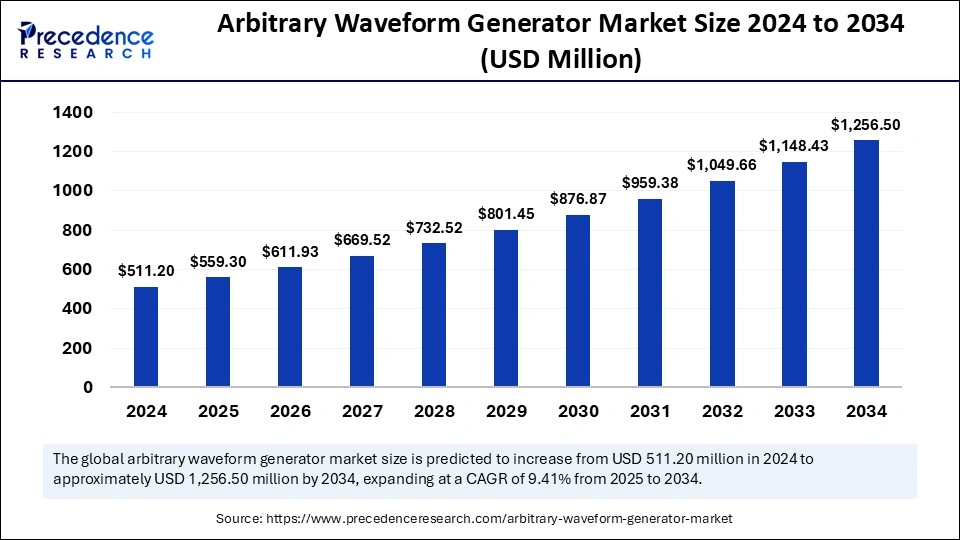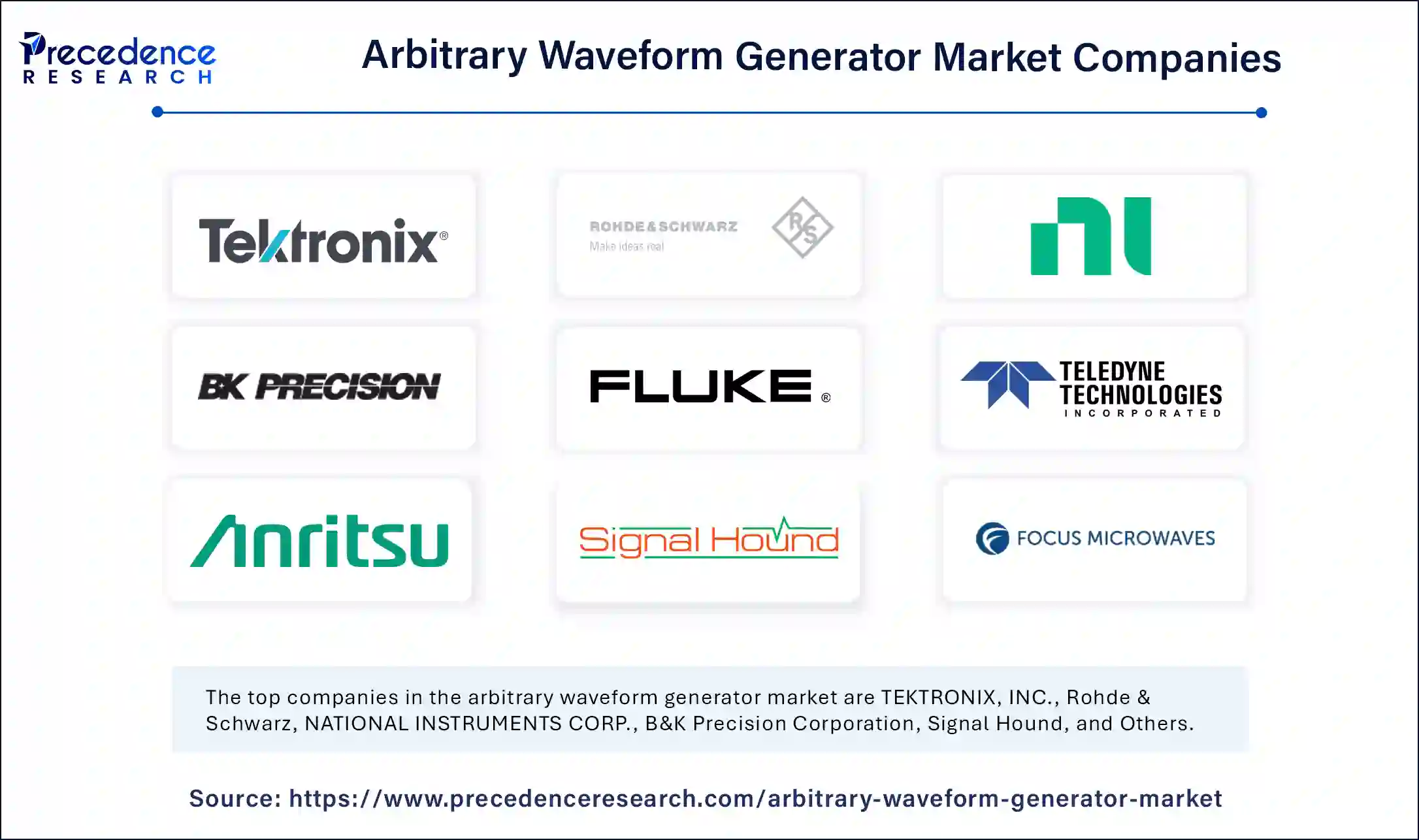Arbitrary Waveform Generator Market Size to Achieve USD 1,256.50 Million by 2034
Arbitrary Waveform Generator Market Size and Growth
The global arbitrary waveform generator market size was valued at USD 511.20 million in 2024 and is expected to achieve around USD 1,256.50 million by 2034, growing at a CAGR of 9.41%.

Arbitrary Waveform Generator Market Key Insights
-
North America accounted for 42% of the total market share in 2024, making it the dominant region.
-
Asia Pacific is anticipated to witness the highest growth in the coming years.
-
The dual-channel segment emerged as the leading product category, contributing 42% of the market share in 2024.
-
The single-channel segment is expected to expand at the most significant rate throughout the forecast period.
-
By technology, the direct digital synthesis segment secured the highest market share in 2024.
-
The combined AWG segment is projected to register the highest CAGR in the coming years.
-
The telecommunications sector led the market by application in 2024.
-
The education sector is forecasted to experience the fastest growth from 2025 to 2034.
Role of AI in the Arbitrary Waveform Generator (AWG) Market
Artificial Intelligence (AI) is playing a transformative role in the arbitrary waveform generator (AWG) market, enhancing performance, efficiency, and automation in signal generation and waveform synthesis. AI-powered AWGs enable real-time waveform optimization, allowing for dynamic adjustments based on application-specific requirements. By leveraging machine learning algorithms, AWGs can analyze historical signal data and predict optimal waveform configurations, leading to improved accuracy and signal integrity. This is particularly beneficial in industries such as telecommunications, aerospace, and defense, where precise signal generation is crucial for testing and research applications.
AI also improves the usability and automation of AWGs by enabling smart calibration and self-correcting functionalities. AI-driven AWGs can automatically detect errors in signal outputs and adjust parameters to ensure high-precision waveforms, reducing manual intervention. Additionally, AI enhances signal processing capabilities by enabling adaptive noise filtering, error correction, and pattern recognition, making AWGs more efficient in high-frequency applications. As AI technology continues to evolve, it is expected to drive further innovations in the AWG market, enhancing speed, flexibility, and overall functionality across various industries.
Arbitrary Waveform Generator (AWG) Overview
An Arbitrary Waveform Generator (AWG) is an advanced signal-generating device used to create user-defined electrical waveforms with high precision and flexibility. Unlike traditional function generators that produce standard waveforms like sine, square, and triangle waves, AWGs can generate complex, customized waveforms based on digital input data. This makes them essential for testing, research, and development in industries such as telecommunications, aerospace, defense, medical, and electronics.
Key Features of AWG
-
Custom Waveform Generation – Users can design and generate complex signals tailored to specific testing needs.
-
High Sampling Rate & Resolution – AWGs offer high-frequency sampling and fine resolution, ensuring accurate signal reproduction.
-
Multiple Channels – Available in single or dual-channel configurations for generating synchronized waveforms.
-
Modulation Capabilities – Supports various modulation techniques such as amplitude, frequency, and phase modulation.
-
Digital Control & Connectivity – Often equipped with software interfaces, USB, Ethernet, and other digital control options for seamless integration with test systems.
Applications of AWG
-
Telecommunications – Used for testing wireless communication systems, signal integrity analysis, and RF component testing.
-
Aerospace & Defense – Employed in radar signal simulation, electronic warfare, and secure communication testing.
-
Semiconductor Testing – Helps in evaluating microchips, circuit designs, and electronic components.
-
Medical Devices – Used in biomedical signal processing and testing of medical imaging equipment.
-
Education & Research – Essential for laboratory experiments, waveform analysis, and advanced signal processing research.
Market Scope
| Report Coverage | Details |
| Market Size by 2034 | USD 1,256.50 Million |
| Market Size in 2025 | USD 559.30 Million |
| Market Size in 2024 | USD 511.20 Million |
| Market Growth Rate from 2025 to 2034 | CAGR of 9.41% |
| Dominated Region | North America |
| Fastest Growing Market | Asia Pacific |
| Base Year | 2024 |
| Forecast Period | 2025 to 2034 |
| Segments Covered | Product, Technology , Applications, and Regions. |
| Regions Covered | North America, Europe, Asia-Pacific, Latin America and Middle East & Africa |
Market Dynamics
Drivers
Key growth drivers include the rise in semiconductor testing requirements, increased deployment of high-speed communication networks, and the growing demand for high-frequency radar systems. The shift toward digitization and automation in industries such as aerospace and healthcare is also driving the adoption of AWGs.
Opportunities
Opportunities in the market lie in AI-powered waveform synthesis, software-defined instruments, and the expansion of applications in biomedical signal processing. The growing trend of remote and cloud-based waveform testing is also expected to open new revenue streams for AWG manufacturers.
Challenges
The primary challenges include the high investment costs associated with advanced AWGs, difficulties in achieving ultra-low latency in high-speed waveform generation, and the complexity of integrating AWGs into existing testing setups. The availability of cost-effective alternatives could also pose a challenge to market expansion.

